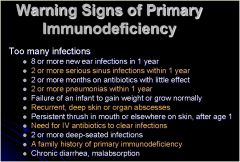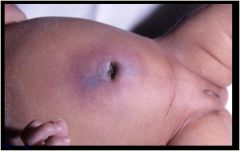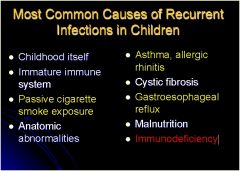![]()
![]()
![]()
Use LEFT and RIGHT arrow keys to navigate between flashcards;
Use UP and DOWN arrow keys to flip the card;
H to show hint;
A reads text to speech;
48 Cards in this Set
- Front
- Back
|
What are some warning signs that a patient might have an immunodeficiency disorder?
*** |

He said this slide was important...
|
|
|
↓ PMNs =
|
fungal infections
|
|
|
↓ B cells/ Antibody =
|
encapsulated bacterial infxn
|
|
|
↓ T cells =
|
intracellular pathogens
bacteria/virus |
|
|
Maternal Ig __ is protective for 3-6 months after birth
|
Maternal IgG
|
|
|
In utero, the fetus begins to produce Ig __ Ab...
|
IgM
|
|
|
serum IgA levels less than 7 mg/dL (Normal ~ 200 mg/dL)
|
Selective IgA deficiency
|
|
|
- Common, 1:500
-Low serum IgA - Most are asymptomatic -Recurrent sinopulmonary infections, GI infections and GI problems -Caution for anaphylactic transfusion reactions |
Selective IgA deficiency
|
|
|
A _6-month-old male patient presents with a bacterial pneumonia infection. History reveals several severe infections and low serum immunoglobulin.
|
X-linked aggamaglobulinemia (Bruton’s aggamaglobulinemia)
|
|
|
-Mutated btk gene on X-chromosome (X-linked)
-Low levels of CD19+ cells; low serum antibody; normal T cells -Low antibody response to vaccines - Infections with extracellular bacteria; pneumonia |
X-linked aggamaglobulinemia (Bruton’s aggamaglobulinemia)
|
|
|
Mutated btk gene on X-chromosome (X-linked)
Low levels of CD19+ cells (B cells); low serum antibody; normal T cells |
X-linked aggamaglobulinemia (Bruton’s aggamaglobulinemia)
|
|
|
A 6-month-old male patient presents with a bacterial pneumonia infection. History reveals several severe infections and low serum IgG and IgA, but high levels of IgM.
|
X-linked Immunodeficiency with Hyper-IgM
|
|
|
- Defect in CD40 ligand on helper T cells
- Impaired antibody class switching and neutropenia - Infections with various pathogens - Increased autoimmunity and malignancy |
X-linked Immunodeficiency with Hyper-IgM
|
|
|
Defect in CD40 ligand on helper T cells
Impaired antibody class switching and neutropenia |
X-linked Immunodeficiency with Hyper-IgM
|
|
|
A _25__ -year-old (M of F) patient presents with a _bacterial respiratory infection. History reveals several severe infections and below normal levels of serum immunoglobulin.
|
CVID
|
|
|
May present at any age; mean age onset ~ 25 years**
- More Common, 1 case per 25,000 – 75,000 - Recurrent sinopulmonary infections, GI infections and GI problems - Serum Ig levels not as low as XLA - Increased incidence of autoimmunity and malignancy |
Chronic Variable Immunodeficiency
(CVID) |
|
|
James is a 14-month old with a history of eight severe recurrent viral and fungal infections. Each infection eventually resolved with treatment, albeit very slowly. The clinical team launch an investigation for the underlying cause and find several abnormalities. The normal thymic shadow was missing from the chest x-ray. Circulating T-cells were greatly diminished.
|
DiGeorge Syndrome
|
|
|
CATCH 22 for DiGeorge Syndrome?
|
C- Cardiac Defects
A- Abnormal Facies T- No Thymus C- Cleft Palate H- Hypocalcemia 22- Chromosome 22 |
|
|
An infant patient presents with absent thymus, a cleft palate, abnormal facial features. The frequently have seizures and are lethargic. This is the 8th time you've seen them for a viral infection
|
DiGeorge Syndrome
CATCH 22 Seizures and lethargy are due to HYPOCALCEMIA |
|
|
Classical Triad:
- X-linked immunodeficiency (abnormal Ig and T cells) - Thrombocytopenia, with small platelets - Eczema |
Wiskott-Aldrich Syndrome
|
|
|
- Only 1/3 of patients have classical triad
- Normally diagnosed within first 2 years - Recurrent sinopulmonary bacterial infections - Mutation in WAS gene on x-chromosome which encodes cytoskeletal regulator protein - Low serum IgM and IgG; possible elevated IgE, IgA - Increased autoimmunity and malignancy |
Wiskott-Aldrich Syndrome
|
|
|
- Mutation in WAS gene on x-chromosome which encodes cytoskeletal regulator protein
- Low serum IgM and IgG; possible elevated IgE, IgA - Recurrent sinopulmonary bacterial infections |
Wiskott-Aldrich Syndrome
|
|
|
• both T and B cells severely affected
• early severe infections, diarrhea, failure to thrive • many different genetic defects; X-linked cγ-chain most common |
SCID
|
|
|
X-linked cγ-chain most common is most common defect
|
SCID
|
|
|
Bubble Boy Syndrome = ?
|
SCID
|
|
|
Tx for SCID?
|
Bone marrow transplant
gene therapy |
|
|
Chronic pneumonia might indicate a ________ deficiency
|
T cell
|
|
|
A _one__ -year-old __male_ patient presents with a _severe bacterial_ infection. History reveals several severe infections and skin abscesses caused by Staphylococcus aureus
|
Chronic granulomatous disease
|
|
|
- X-linked form is most common
- Defective subunit of NADPH oxidase → diminished intracellular killing by Macs and PMN - Age of onset usually < 2 years - Diagnose with nitroblue tetrazolium (NBT) or dihydrorhodamine tests |
Chronic granulomatous disease
|
|
|
- Defective subunit of NADPH oxidase → diminished intracellular killing by Macs and PMN
- Diagnose with nitroblue tetrazolium (NBT) or dihydrorhodamine tests |
Chronic granulomatous disease
|
|
|
defects in _____, the terminal complement components that form the membrane-attack complex, have more limited effects, of which susceptibility to Neisseria is the best example.
|
C5-C9
|
|
|
Defect in C5-C9 leads to decreased formation of MAC complex. What bug are you more susceptible to?
|
Neisseria
|
|
|
What is the most effective defense against Neisseria?
|
complement-mediated lysis of extracellular bacteria
this requires all the components of the complement pathway. |
|
|
C3 acts as an ______ that promotes phagocytosis of bacteria by macrophages and neutrophils.
|
opsonin
|
|
|
Recurrent attacks of edema; subcutaneous and submucosal tissues
- Respiratory obstruction may occur - Deficiency in C1 inhibitor of complement - Excess production of C2-kinin and bradykinin |
Hereditary Angionedema
|
|
|
Deficiency in C1 inhibitor of complement
|
Hereditary Angionedema
|
|
|
A patient with Hereditary Angionedema will have excess production of ____ and _____
|
C2-kinin and bradykinin
|
|
|
Katie is a 22-year-old being evaluated for severe prolonged diarrhea. History reveals numerous respiratory and GI infections throughout her life. She has been hospitalized several times with pneumonia and previous episodes of diarrhea due to Giardia lamblia. You suspect . . .
|
CVID
She's a female, so X-linked are most likely out... |
|
|
- Rare, progressive multi-system disorder of childhood
- First signs → delayed development of motor skills, ataxia at 12 – 18 months - Defect involves mutation in a gene that codes for a kinase involved in DNA repair - Patients very susceptible to radiation damage ~ 20% develop cancer |
Ataxia telangiectasia
|
|
|
mutation in a gene that codes for a kinase involved in DNA repair leads to delayed development of motor skills, ataxia at 12 – 18 months
|
Ataxia telangiectasia
|
|
|
- Patients commonly present with dermatitis, recurrent infections (usually bacterial), skeletal defects, and elevated serum IgE
- Autosomal dominant inheritance of a mutated STAT3 gene - Staphylococcal abscesses (cold) often present*** - Skeletal/dental abnormalities include bone fracture, scoliosis, hyperextensible joints, retention of primary teeth |
Hyper-IgE Syndrome (Job syndrome)
|
|
|
- Autosomal dominant inheritance of a mutated STAT3 gene
- Staphylococcal abscesses (cold) often present -Skeletal deformities and high serum Ig E |
Hyper-IgE Syndrome (Job syndrome)
|
|
|
A __one_ -year-old __________ patient presents with a __bacterial skin__ infection. History reveals several severe infections and a delayed umbilical cord separation after birth.
|
Leukocyte Adhesion Deficiency I
|
|
|
- Beta-2 integrin is deficient or defective (CD18)
- Autosomal recessive inheritance - Delayed separation of umbilical cord; omphalitis - Recurrent bacterial skin and mucosal infections - Lack of pus formation and impaired wound healing - Periodontal disease |
Leukocyte Adhesion Deficiency I
|
|
|
Beta-2 integrin is deficient or defective (CD18)
|
Leukocyte Adhesion Deficiency I
|
|
|
Defects in integrins make PMNs unable to leave the bloodstream to respond to infection/injury. There is ABNORMAL PUS FORMATION
|
Leukocyte Adhesion Deficiency I
|
|

What's going on here?
|
Omphalitis in a newborn with leukocyte adhesion deficiency
|
|
|
What are some of the most common causes of recurrent infection in children?
*** |

|

